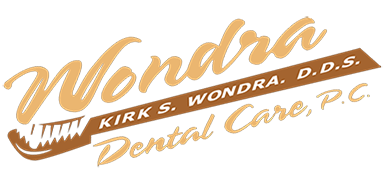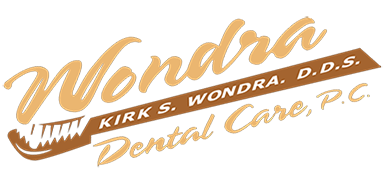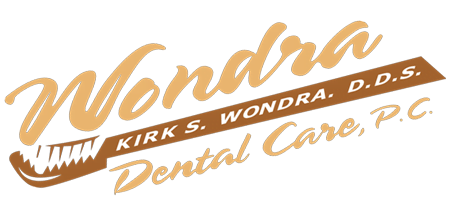Restorative Dentistry
Regular check-ups and cleanings can help ensure the health of your teeth. Unfortunately, it is sometimes necessary to repair damaged teeth. These repairs usually fall into one of three categories: fillings, onlays and crowns.
Same-day Crowns at Wondra Dental
Did you Know?
The ceramic crowns are designed and applied in a single visit using the advanced CEREC system. This dynamic software takes the guesswork out of crown design. They are almost indistinguishable from natural teeth, and the bonding process provides a superior bond to your teeth.
What is a CEREC Dental Crown?
CEREC in dentistry terms stands for Chairside Economical Restoration of Esthetic Ceramics. This refers to a system that uses computer-aided design and computer-aided manufacturing (CAD/CAM) to construct materials for dental restoration. This state-of-the-art technology can design crowns, dental implants, fixed bridges, inlays and onlays, veneers, dentures, and some orthodontic appliances.
Dentists can now create dental crowns in various materials, including metal, porcelain, ceramic, and resin. A CEREC crown, however, is made out of extremely durable ceramic. Since they use computer-assisted technology available on-site to design, create, and install these crowns, the entire process can take a single visit.
When the majority of the upper tooth has been damaged and needs to be replaced, a crown may be in order. Dr. Wondra offers crowns in ceramic or gold. Gold crowns are appropriate when appearance is not a priority. The gold metal is malleable, making them fit precisely. There exists a slight possibility (around 1 in 100) of chipping with porcelain crowns, but gold will not chip.
What can CEREC do for you?
CEREC is a computer-aided design and computer-aided manufacturing (CAD/CAM) system used in dentistry to create same day crowns and other dental restorations in a single visit.
With this complete, in-office system, we can create long-lasting ceramic crowns and more—in a single visit, in as little as one hour. That means a healthier smile for you in less time.

Before CEREC

After CEREC
Dental Services & Technology
Wondra Dental Care is differentiated by our pursuit of education and technology. In our hands, these innovations offer patients a superior standard of care.

Spear Education provides dental continuing education for striving dentists that are dedicated to the pursuit of clinical excellence in dentistry.

Cerec is a technology allowing dentists to provide patients with high-quality restorations, modern treatments, and comfortable treatments. And the best of all is a successful final restoration in just one visit.

An American dental equipment maker and dental consumables producer that markets its products in over 120 countries.
Teeth Whitening at Wondra Dental
Did you know?
Over-the-counter bleaching products are not endorsed by the ADA.
Take-home Trays
If you would like to brighten your smile, teeth whitening might be an option for you. We offer patients a personalized professional teeth whitening experience in the comfort of their own home. The customized whitening trays are tailored to the patient’s smile, enhancing patient comfort and providing them the attention their smile deserves. Its efficient syringe delivery is simple to use with the custom trays and allows for the patient to dispense just the right amount of whitening gel necessary for each application. We offer 20% and 30% concentration.
Opalescence Whitening is 20% carbamide peroxide suspension that is provided for daily use up to 10 days initially. You can wear the trays in the convenience of your home and touch up, as needed.


Nightguards
Nightguards are custom-made to treat tooth clenching or grinding and prevent excessive wear and fractures to the tooth surfaces while you sleep.
Mouthguards
Sports Mouthguards
Dental injuries are the most common type of orificial injury sustained during participation in sports, according to the National Youth Sports Foundation for Safety.
An athlete is 60 times more likely to endure damage to the teeth when not wearing a mouth guard. It is estimated that mouthguards professionally designed by dentists prevent approximately 200,000 injuries, such as concussions and dental and mandibular injuries, each year in high school and college football.
The stock mouthguard, which can be purchased at sports stores without an individual fitting, provides only a low level of protection, if any. Our office can fit you for a custom made sportguard, specific for your athletic needs.
Veneers
There’s no reason to put up with gaps in your teeth that are stained, badly shaped or crooked. Today, a veneer placed on top of your teeth can correct nature’s mistake or the results of an injury and help you to have a beautiful smile.
Dental veneers are wafer-thin, custom-made shells of tooth-colored materials designed to cover the front surface of teeth to improve your appearance. The shells are bonded to the font of the teeth changing their color, shape and size or length.
Some of the top reasons for having veneers are:
Teeth that are discolored – because of root canal treatment, stains from tetracycline or other drugs, excessive fluoride or other causes, or the presence of large resin fillings that have discolored the tooth
- Teeth that are worn down, chipped or broken
- Teeth that are misaligned, uneven or irregularly shaped
- Teeth with gaps between the


Dental Implants
Dental Implants are long term replacements for missing teeth. The advantage of dental implants is that surrounding teeth do not need to be compromised. A specialist will place the implant and then upon healing, Dr. Wondra can have the implant crown fabricated. Dental Implants can also be used to anchor dentures, to help alleviate mobility.
Dental Sealants at Wondra Dental
Did you know?
According to the CDC School-age children (6-11) without sealants have almost 3 times as many cavities in the first molars as children who do have sealants.
Source
Sealants are offered for every child and adult! Sealants are a protective barrier on the chewing surfaces of molars to protect the grooves from decay. Ultradent Sealants provide the highest level of protection for you and your family.
According to the Center for Disease Control here are some frequently asked questions about dental Sealants:







